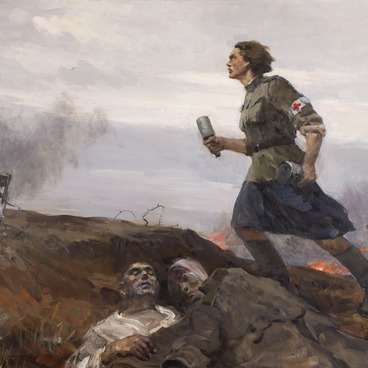Pyotr Kupriyanov was born in St. Petersburg in 1893. He graduated from the 7th St. Petersburg Gymnasium and entered the Imperial Military Medical Academy in 1911. After completing the fourth year of studies, he was drafted into the military.
Between 1915 and 1917, Kupriyanov served as a divisional infirmary resident and an artillery brigade doctor. In 1918, he graduated with honors from the Military Medical Academy, where he stayed as a teacher at the department of operative surgery and regional anatomy.
At the same time, he worked in the clinic of Vladimir Oppel and Sergey Fyodorov. During the Winter War, he was appointed the chief frontline surgeon. During the Great Patriotic War, he became the chief surgeon of the Northern and Leningrad Fronts.
Pyotr Kupriyanov often worked at the foremost defenses amid fierce battles. He supervised the organization of hospitals for the lightly wounded. Mobile hospitals for general treatment in the field were organized alongside portable surgical hospitals. As a result, experienced physicians contributed both to the treatment of the wounded and post-surgery patient care.
Along with his responsibilities as the chief frontline surgeon, Pyotr Kupriyanov personally supervised the operation of a hospital for chest injuries. After the end of the war, the experience of leading Soviet medical scientists was summarized in landmark publications, including “The Experience of Soviet Medicine in the Great Patriotic War of 1941–1945” in thirty-five volumes, “The Soviet Navy Medical Corps in the Great Patriotic War of 1941–1945” in three volumes, and “Encyclopedic Dictionary of Military Medicine” in six volumes.
These books summarized the enormous heroic efforts of the doctors who had worked and fought for victory in the Great Patriotic War. In 1958, Kupriyanov initiated the establishment of the first department of anesthesiology in the USSR, which he headed until 1963. A mold of the right hand of Professor Pyotr Kupriyanov was made by Valentina Yablokova.
Between 1915 and 1917, Kupriyanov served as a divisional infirmary resident and an artillery brigade doctor. In 1918, he graduated with honors from the Military Medical Academy, where he stayed as a teacher at the department of operative surgery and regional anatomy.
At the same time, he worked in the clinic of Vladimir Oppel and Sergey Fyodorov. During the Winter War, he was appointed the chief frontline surgeon. During the Great Patriotic War, he became the chief surgeon of the Northern and Leningrad Fronts.
Pyotr Kupriyanov often worked at the foremost defenses amid fierce battles. He supervised the organization of hospitals for the lightly wounded. Mobile hospitals for general treatment in the field were organized alongside portable surgical hospitals. As a result, experienced physicians contributed both to the treatment of the wounded and post-surgery patient care.
Along with his responsibilities as the chief frontline surgeon, Pyotr Kupriyanov personally supervised the operation of a hospital for chest injuries. After the end of the war, the experience of leading Soviet medical scientists was summarized in landmark publications, including “The Experience of Soviet Medicine in the Great Patriotic War of 1941–1945” in thirty-five volumes, “The Soviet Navy Medical Corps in the Great Patriotic War of 1941–1945” in three volumes, and “Encyclopedic Dictionary of Military Medicine” in six volumes.
These books summarized the enormous heroic efforts of the doctors who had worked and fought for victory in the Great Patriotic War. In 1958, Kupriyanov initiated the establishment of the first department of anesthesiology in the USSR, which he headed until 1963. A mold of the right hand of Professor Pyotr Kupriyanov was made by Valentina Yablokova.


